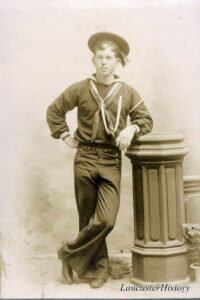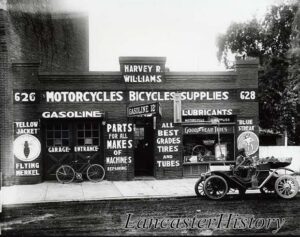Looking For a Date | Save Your Photos Month
This entry is the last part of a series celebrating of September’s Save Your Photos Month. We hope you enjoyed this series!
While organizing family photographs, it’s totally par for the course to find undated, unidentified, or just plain unknown images. Don’t worry. There are various ways of giving these pictures a time frame that may help with further identification.
Check the Ads

As print photography took off in the 1860s and 1870s, photographers used their medium to advertise their services. On the backs, on the bottoms, in the corners – photographers used various spaces on their products to print or emboss logos of their names or studios. Check local city or county directories to find out when a particular photographer was in business. This will provide a time frame for when a photo was taken.
Fashion

Beehive hairdos? Definitely the 1960s. Hip hugger bellbottoms? Hello, 1970s. Clothing and hairstyles are a great way to decipher when a photograph was taken. Fashion keeps on changing – from the hoop skirts of the 1860s to the puffy leg-o-mutton sleeves of the 1890s to the various forms of facial hair in the 1870s and 1880s. Your ancestors’ style can say a lot about a photograph – most importantly when it was taken.
In Uniform

Clothing worn on the job or for a purpose can often tell a story. Military uniforms, for example, may have patches or medals that might indicate a particular rank, unit or division, the number of tours of duty served, or service on a ship or in a campaign. Sports uniforms may have identifiable logos. First responder uniforms may have distinctive hats or badges.
In the Details
Sometimes it’s just a matter of looking at the all the tiny details in a photograph. Candid photography – that is non-portraiture photography – may rely on landscape details. Street signs, hood ornaments, logos, vehicles, even architecture – anything can help piece together the puzzle of unidentified photographs.

Resources for the Photo Sleuth
LancasterHistory has several great resources in the Research Center for helping the family historian (and photo sleuth!) identify old photographs, from fashion through the years to the types of photographic images to the photographers that took them!
Don’t Let Dating Be a Drag
We’ve compiled a list of books in the Research Center that one can consult. Those interested in spending time with these reads can purchase a ticket to the Research Center. (Learn more about that here!)
- Dating Old Photographs, 1840-1929, Halvor Moorhead, editor. Family Chronicle Publications, Toronto, Canada, 2000.
- Bogdan, Robert and Todd Weseloh, Real Photo Postcard Guide. Syracuse University Press, Syracuse, NY, 2006.
- Ries, Linda A. and Jay W. Ruby, Directory of Pennsylvania Photographers, 1839-1900. Pennsylvania Historical and Museum Commission, 1999.
- Severa, Joan L., Dressed For the Photographer, Ordinary Americans & Fashion, 1840-1900. Kent State University Press, Kent, Ohio, 1995.
- Severa, Joan L., My Likeness Taken – Daguerreian Portraits in America. Kent State University Press, Kent, Ohio, 2005.
- Seibert, Peter S., How We Lived, 1880-1940. Schiffer Publishing, Ltd., Atglen, PA, 2003.
Organization & Preservation
The books below, also found in our Research Center, provide great guidance in managing and caring for your family photographs.
- Taylor, Maureen, Preserving Your Family Photographs: How to Organize, Present, and Restore Your Precious Family Images. Betterway Books, Cincinnati, Ohio, 2001.
- Taylor, Maureen, Uncovering Your Ancestry Through Family Photographs. Betterway Books, Cincinnati, Ohio, 2000.
- Rempel, Siegfried, The Care of Photographs. Lyons & Burford, New York, NY, 1987.
- Reilly, James M., Care and Identification of 19th Century Photographic Prints. Eastman Kodak Company, Rochester, NY, 1986.
- Ritzenthaler, Mary Lynn, et al., Photographs: Archival Care and Management. Society of American Archivists, Chicago, IL, 2006.
On the Web
A little internet sleuthing can bring loads of information just in case you can’t travel to our Research Center. Here are some helpful sites to get you started.
(Please note that clicking the links below will take you off LancasterHistory’s website and to another website. LancasterHistory provides these links for informational purposes only and is not responsible for the content or privacy practices of the sites. Links to retailers do not constitute an official endorsement.)
- https://maureentaylor.com/: Not only is Taylor an author, as listed above, but she hosts a podcast, provides consultation, and has created a helpful website for family photo curators in need of assistance.
- https://thephotomanagers.com/:This is the website of the creators of Save Your Photos Month. Dedicated to helping folks organize their collections of family photographs, they provide a variety of educational services and organizational help.
- https://www.gaylord.com/: Gaylord Bros. sells archival quality supplies to help you preserve and store your images. Your local craft store may also carry certain supplies, but always make sure they’re acid free and lignin free. Other online retailers include https://www.universityproducts.com/ and http://www.lightimpressionsdirect.com/.
